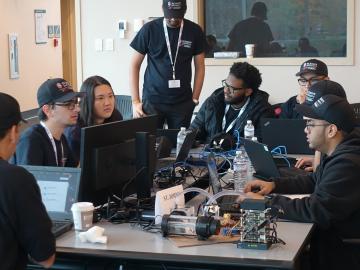
Filter News
Area of Research
- (-) Materials (59)
- (-) National Security (13)
- (-) Supercomputing (45)
- Advanced Manufacturing (3)
- Biology and Environment (17)
- Computational Engineering (1)
- Computer Science (4)
- Energy Frontier Research Centers (1)
- Energy Science (52)
- Fusion and Fission (6)
- Isotope Development and Production (1)
- Isotopes (7)
- Materials Characterization (1)
- Materials for Computing (9)
- Materials Under Extremes (1)
- Neutron Science (18)
- Nuclear Science and Technology (5)
- Quantum information Science (1)
News Type
News Topics
- (-) Artificial Intelligence (19)
- (-) Computer Science (36)
- (-) Grid (6)
- (-) Isotopes (5)
- (-) Materials Science (37)
- (-) Nanotechnology (23)
- (-) Polymers (6)
- 3-D Printing/Advanced Manufacturing (16)
- Advanced Reactors (2)
- Big Data (1)
- Bioenergy (13)
- Biology (8)
- Biomedical (7)
- Biotechnology (1)
- Buildings (3)
- Chemical Sciences (20)
- Composites (3)
- Coronavirus (7)
- Critical Materials (8)
- Cybersecurity (13)
- Energy Storage (20)
- Environment (11)
- Exascale Computing (7)
- Frontier (12)
- Fusion (3)
- High-Performance Computing (13)
- ITER (1)
- Machine Learning (8)
- Materials (41)
- Microscopy (13)
- Molten Salt (2)
- National Security (11)
- Neutron Science (23)
- Nuclear Energy (5)
- Partnerships (11)
- Physics (17)
- Quantum Computing (5)
- Quantum Science (17)
- Security (7)
- Simulation (1)
- Space Exploration (1)
- Summit (14)
- Transportation (6)
Media Contacts

For the second year in a row, a team from the Department of Energy’s Oak Ridge and Los Alamos national laboratories led a demonstration hosted by EPB, a community-based utility and telecommunications company serving Chattanooga, Tennessee.

OAK RIDGE, Tenn., Feb. 27, 2020 — Researchers at Oak Ridge National Laboratory and the University of Tennessee achieved a rare look at the inner workings of polymer self-assembly at an oil-water interface to advance materials for neuromorphic computing and bio-inspired technologies.

Energy storage startup SPARKZ Inc. has exclusively licensed five battery technologies from the Department of Energy’s Oak Ridge National Laboratory designed to eliminate cobalt metal in lithium-ion batteries. The advancement is aimed at accelerating the production of electric vehicles and energy storage solutions for the power grid.

An international team of researchers has discovered the hydrogen atoms in a metal hydride material are much more tightly spaced than had been predicted for decades — a feature that could possibly facilitate superconductivity at or near room temperature and pressure.

Rigoberto “Gobet” Advincula has been named Governor’s Chair of Advanced and Nanostructured Materials at Oak Ridge National Laboratory and the University of Tennessee.

Gina Tourassi has been appointed as director of the National Center for Computational Sciences, a division of the Computing and Computational Sciences Directorate at Oak Ridge National Laboratory.

The U.S. Department of Energy’s Office of Science announced allocations of supercomputer access to 47 science projects for 2020.

Oak Ridge National Laboratory will give college students the chance to practice cybersecurity skills in a real-world setting as a host of the Department of Energy’s fifth collegiate CyberForce Competition on Nov. 16. The event brings together student teams from across the country to compete at 10 of DOE’s national laboratories.

Researchers at the Department of Energy’s Oak Ridge National Laboratory have received five 2019 R&D 100 Awards, increasing the lab’s total to 221 since the award’s inception in 1963.

A joint research team from Google Inc., NASA Ames Research Center, and the Department of Energy’s Oak Ridge National Laboratory has demonstrated that a quantum computer can outperform a classical computer


